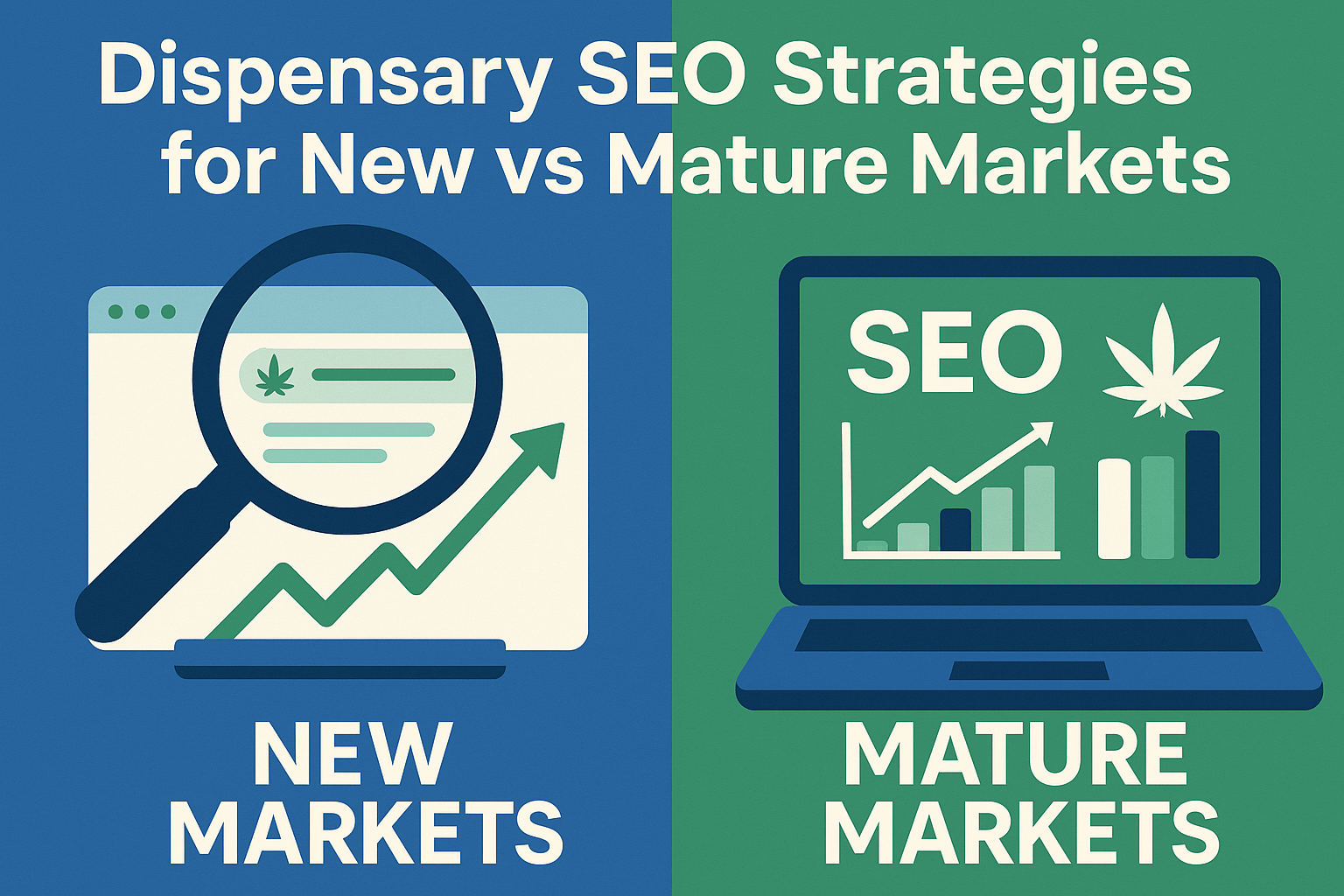Quick Takeaways
– New markets require hyper-local SEO focused on “near me” searches and Google Business Profile optimization to capture first-time legal buyers seeking convenient access.
– Transitioning markets demand educational content and mid-funnel optimization as consumers move from asking “where to buy” to “what to buy.”
– Mature markets need product-led SEO with indexable menus and long-tail keyword targeting to compete for specific brand and strain searches.
– The right e-commerce technology becomes critical in mature markets—iFrame menus cost you visibility and revenue by making your products invisible to search engines.
– AI search and generative engines are reshaping SEO across all market phases, requiring new optimization strategies beyond traditional Google rankings.
Get Your Cannabis SEO Strategy Right
Whether you’re entering a new market or competing in an established one, NisonCo’s SEO team knows what works. We’ve helped cannabis dispensaries across the country adapt their strategies to market conditions. Schedule a free SEO consultation to discuss your market and goals.
Understanding the SEO Cycle in Cannabis Markets
Think of cannabis market maturity as a three-phase cycle, each requiring a fundamentally different approach to search optimization.
Phase 1 (New Market): Consumers need to find you. They’re asking “where can I legally buy cannabis?” Your job is to be the most visible answer to that question in your immediate area.
Phase 2 (Transitioning Market): Consumers want to learn. They’re asking “what should I buy?” Your job is to become their most trusted educational resource.
Phase 3 (Mature Market): Consumers know exactly what they want. They’re asking “where can I buy this specific product?” Your job is to rank for thousands of product-specific searches.
The dispensaries that recognize which phase their market is in—and adjust their strategy accordingly—are the ones that dominate their competition. At NisonCo, we track these transitions closely with our clients, adjusting tactics as we see consumer behavior shift in real-time through search data.
New Market Strategy: Winning the Local Search Battle
When recreational cannabis first becomes legal in a state, you’re not just competing with other dispensaries. You’re competing with consumer uncertainty and the established illegal market. Your first priority is proving you exist, you’re legal, and you’re convenient.
Why “Near Me” Searches Dominate New Markets
In newly legalized markets, the vast majority of cannabis searches include location terms and happen on mobile devices. Consumers aren’t brand-loyal yet because they haven’t developed preferences. They’re solving a simple problem: finding the closest legal dispensary.
This behavior creates an obvious strategic priority—own the local search results.
Your Google Business Profile is Your Most Valuable Asset
In a new market, your Google Business Profile (GBP) matters more than your website. This profile powers your appearance in the Map Pack—those three business listings at the top of “near me” searches. Getting into that Map Pack is the difference between a steady stream of foot traffic and an empty store.
Here’s what a properly optimized GBP requires:
– Complete and accurate NAP data: Your business Name, Address, and Phone number must be identical across every online platform. Google treats inconsistencies as a trust issue.
– Correct categorization: Select “Cannabis store” as your primary category. Seems obvious, but choosing the wrong category makes you invisible to relevant searches.
– High-quality photos: Dispensaries with professional photos of their storefront, interior, and products receive significantly more direction requests and clicks. Show customers what to expect before they visit.
– Active management: Post regular updates about new products, promotions, or events. Respond to every review, positive or negative. These activity signals tell Google your business is engaged and trustworthy.
Build Local Authority Beyond Your GBP
Your Google Business Profile is the foundation, but you need to reinforce it with broader local signals:
Local citations matter. Get your dispensary listed on cannabis-specific directories like Weedmaps and Leafly, plus general business directories like Yelp. Make sure your NAP data is perfectly consistent across all of them—these act as third-party verifications of your legitimacy and location.
On-page local SEO connects your website to your physical location. If you have multiple stores, create a unique landing page for each one with the full address, embedded map, and location-specific content. Use neighborhood names in your page titles and headers (“Downtown Denver Dispensary” not just “Our Location”).
Mobile optimization is non-negotiable. When someone searches for a dispensary while driving or walking, a slow-loading site means they’ll move to the next result. Speed and mobile-friendliness directly impact your rankings and conversion rates.
You’re Fighting More Than Competitors
New markets present a unique challenge: many of your potential customers have only purchased cannabis illegally. They might be uncertain about the legal experience, worried about being judged, or simply more comfortable with their existing source.
Your SEO strategy needs to counter this inertia. A well-optimized GBP with dozens of positive reviews, professional photos, and clear descriptions does more than help people find you—it builds trust and signals legitimacy. You’re not just saying “we exist,” you’re saying “we’re a trustworthy alternative to what you’ve been doing.”
And since Google and Meta heavily restrict cannabis advertising, organic search becomes your most reliable customer acquisition channel. You can’t pay your way to the top like retailers in other industries. SEO isn’t just important in new markets—it’s often your only scalable option for visibility.
Transitioning Market Strategy: From Location to Education
As your market matures, consumer behavior shifts noticeably. People stop searching for “any dispensary” and start searching for “the right product.” This transition happens gradually, but once it begins, dispensaries that rely solely on local SEO start losing ground.
What Drives the Shift to Informational Searches
Three factors accelerate this evolution:
Product proliferation: New markets start with flower and maybe a few edibles. Within a year or two, shelves fill with vapes, tinctures, topicals, beverages, and concentrates. Consumers face overwhelming choice and need guidance.
Growing knowledge: Through trial and error, consumers learn about THC, CBD, terpenes, and strain differences. They develop preferences for specific effects—relaxation, focus, pain relief, better sleep. Their searches reflect this sophistication: “best sativa for creativity” or “high-CBD edibles for anxiety.”
Brand emergence: As the market matures, certain brands build reputations for quality or innovation. Consumers start seeking out specific manufacturers, not just generic products.
The common thread? Consumers are moving from the bottom of your sales funnel (“where to buy”) to the middle (“what to buy”). Your SEO strategy must expand to meet them there.
Content Marketing Becomes Your Competitive Advantage
To capture these informational searches, your website needs to become a resource, not just a storefront. This requires a significant investment in educational content.
Start a blog if you haven’t already. Publish well-researched articles that answer common questions: “What’s the difference between live resin and distillate?” “How do terpenes affect your high?” “Best cannabis products for first-time users.” These pieces attract organic traffic from people in the research phase of their buying journey.
Optimize category pages beyond simple product listings. Your “Edibles” page shouldn’t just show products—it should explain what edibles are, how they differ from smoking, dosage guidelines, and onset times. This educational approach helps users navigate your offerings while improving your rankings for category-level searches.
Target mid-funnel keywords that indicate research intent. Tools like Google Keyword Planner or Ahrefs will show you questions people are actually asking: “how long do edibles last,” “indica vs sativa for sleep,” “what is live rosin.” Build content around these queries.
The AI Search Factor: Optimizing for Generative Engines
Here’s something we’ve learned through our own testing at NisonCo: AI search is changing how people find information about cannabis. ChatGPT, Perplexity, and Google’s AI overviews are becoming primary research tools, especially for consumers in transitioning markets who want quick, consolidated answers.
Our analytics show that a growing percentage of dispensary website traffic now comes from AI search engines. This means your content strategy needs to adapt:
Add FAQ sections to your key pages. AI engines pull heavily from well-structured question-and-answer content. When someone asks ChatGPT “what’s the difference between indica and sativa,” having a clear FAQ on your site increases your chances of being cited as the source.
Include concise summary sections. We’ve found that placing key takeaways at the top of articles—much like the “Quick Takeaways” at the start of this post—helps AI engines extract and cite your information more effectively.
Ensure your About page is credible and detailed. AI engines verify source credibility before citing information. A robust About page with your team’s expertise, years in business, and credentials significantly improves your chances of being referenced by AI search tools.
We track how our clients rank in AI search results, and the data is clear: dispensaries optimizing for both traditional and AI search are capturing more of the transitioning market’s research traffic.
Why This Phase Creates Lasting Competitive Advantage
Here’s the strategic insight many dispensaries miss: educational content takes time to rank. Building topical authority with search engines requires months of consistent publishing and optimization.
If you start investing in content marketing during the transition phase—while your competitors are still focused exclusively on local SEO—you create what we call a “content moat.” By the time the market fully matures and everyone realizes they need informational content, you’ll have months or years of established authority. Your competitors will struggle to catch up.
The dispensaries that wait until mature market conditions to start content marketing find themselves fighting an uphill battle against competitors who planned ahead.
Mature Market Strategy: Product-Led SEO at Scale
In markets like Colorado or California, consumer behavior looks nothing like new market patterns. These shoppers know what they want. They have favorite brands, preferred strains, and specific product formats. They’re not discovering cannabis—they’re shopping for it.
This creates an entirely different competitive landscape where product-level SEO becomes your primary battleground.
How Sophisticated Consumers Search
Mature market searches are hyper-specific and transactional. Instead of “dispensary near me,” you’ll see:
– “Ozone live resin cartridge Denver”
– “Buy Jeeter pre-rolls near me”
– “Wana gummies for sale”
– “Cake strain [neighborhood name]”
These are high-intent, ready-to-buy searches. The person typing that query isn’t browsing—they’re looking for the best place to purchase a specific product they already want. If your dispensary doesn’t appear for these searches, you’re invisible to your most valuable potential customers.
Your Product Pages Are Your Most Valuable SEO Assets
In a mature market, your homepage and blog matter less than your individual product pages. Your online menu becomes your primary SEO asset—but only if it’s technically set up correctly.
The iFrame menu problem: Many dispensaries use third-party menu services that embed their products in an iFrame on their website. This is a catastrophic SEO mistake. Search engines often can’t crawl or index content inside iFrames, which means your entire product catalog is invisible to Google. You get zero SEO benefit from your inventory.
We’ve had multiple client discussions about this exact issue. One client was considering a migration from HubSpot to WordPress specifically to address menu indexability problems. The technical setup of your menu isn’t just an IT decision—it’s a fundamental SEO strategy choice that determines whether you can compete in mature markets.
The solution: Your menu must be native to your website, with each product and category having its own unique, indexable URL. This technical requirement isn’t optional—it’s the foundation of mature market SEO.
Optimizing Product Pages for Maximum Visibility
Once your menu is technically sound, optimization becomes critical:
Write unique product descriptions. Using manufacturer-provided copy creates duplicate content problems and prevents your pages from ranking. Each product needs a compelling, keyword-rich description written specifically for your site.
Use high-quality images for every product. Multiple photos per product is ideal. Optimize images for fast loading and include descriptive alt text with relevant keywords.
Implement schema markup. Product and review schema helps Google understand your content and can generate rich snippets in search results—star ratings, review counts, and pricing that appear directly in the search results and dramatically increase click-through rates.
Build strong site architecture. Create clear category pages (Flower, Edibles, Vapes) with logical navigation and robust internal linking. Your URLs should be clean and keyword-rich: yourdispensary.com/vapes/pax-era-pro not yourdispensary.com/products?id=12847.
Content Strategy in Mature Markets: Going Deep
Your content approach needs to evolve beyond basic education to establish deep expertise and capture long-tail keywords with strong purchase intent.
Create authoritative comparison content: “Top 5 Live Resin Cartridges in Colorado” or “Ozone Gummies vs. Wana Gummies: Complete Review.” These pieces target specific product searches and position you as the expert.
Develop geo-targeted product content that combines specific products with locations: “Where to Find Jeeter Pre-rolls in Capitol Hill.” This directly targets the highest-intent searches in mature markets.
Write about cannabis science in depth: “How Terpenes Influence Your High” or “Understanding CBN for Better Sleep.” Sophisticated consumers want this level of detail.
The PR-SEO Integration in Mature Markets
One strategy we’ve been testing with select clients is what we call “PR for SEO”—integrating traditional public relations with search optimization in mature markets.
The concept is straightforward: PR coverage builds brand authority that supports SEO efforts, while SEO insights inform which topics to pitch to journalists. When a dispensary gets featured in industry publications or mainstream media, those backlinks and brand mentions significantly boost search rankings for competitive product terms.
We’ve seen this work particularly well for clients who need to differentiate in saturated markets. The combination of strong product-page SEO and authoritative media coverage creates a compounding effect that’s difficult for competitors to replicate.
The Technology Factor: Programmatic SEO Wins Mature Markets
Here’s where mature market SEO becomes a technology game. Manually creating and optimizing unique pages for hundreds or thousands of products is logistically impossible.
The winning solution is programmatic SEO—systems that automatically generate optimized, indexable product pages from your inventory data. This isn’t a nice-to-have feature; it’s the fundamental engine that allows you to compete at scale.
Consider the Ascend case study: after switching from an iFrame menu to an SEO-friendly platform that programmatically created product pages, they saw a 49% increase in organic traffic within 90 days. Their ranking keywords grew from 7,600 to 17,000. Most importantly, organic search generated $44 million in revenue in just three months.
In mature markets, your choice of e-commerce platform is your SEO strategy. The right technology lets you rank for thousands of product searches simultaneously. The wrong technology makes you invisible.
Aligning Your Strategy with Your Market Reality
The biggest mistake cannabis dispensaries make is using the wrong strategy for their market maturity level. A new market dispensary that invests heavily in product comparison content before consumers have established preferences wastes resources. A mature market dispensary that focuses exclusively on “dispensary near me” while ignoring product searches bleeds revenue to competitors.
Diagnose your market honestly:
– New market indicators: Recreational legalization happened within the last 12-18 months. Consumers primarily search for location-based terms. Product knowledge is low. Few established brands.
– Transitioning market indicators: Market is 1-3 years old. You’re seeing more question-based searches. Consumers ask staff detailed questions about effects and products. Multiple brands are gaining recognition.
– Mature market indicators: Market is 3+ years old. Heavy competition with many dispensaries. Consumers mention specific brands and strains. Search queries include product names and comparisons.
Once you’ve accurately identified your market phase, you can allocate resources appropriately. New markets need GBP obsession. Transitioning markets need content investment. Mature markets need technical e-commerce excellence.
And remember: this is a cumulative cycle, not a sequence of replacements. Mature market dispensaries still need strong local SEO—they just need to build product optimization on top of that foundation.
Ready to Optimize Your Dispensary SEO Strategy?
The cannabis industry moves fast, and SEO strategies that worked six months ago might not work today. Whether you’re entering a new market or fighting for position in a mature one, having the right strategy makes the difference between growth and stagnation.
NisonCo has over a decade of experience helping cannabis dispensaries dominate their local markets. We’ve guided clients through every phase of the SEO cycle, from launch in new markets to sophisticated product optimization in competitive landscapes. Our team doesn’t just follow industry best practices—we develop new approaches through hands-on testing with real clients, from AI search optimization strategies to methods for ranking in generative engines.
We understand the unique challenges cannabis businesses face with advertising restrictions, making organic search optimization absolutely critical for sustainable growth. Our approach combines traditional SEO fundamentals with cutting-edge techniques like generative engine optimization and programmatic content strategies.
Contact us today to discuss your market conditions and develop an SEO strategy that actually matches where your consumers are in their journey. We’ll analyze your current approach, identify opportunities your competitors are missing, and build a roadmap for measurable growth.
Your market is evolving. Your SEO strategy should too.



